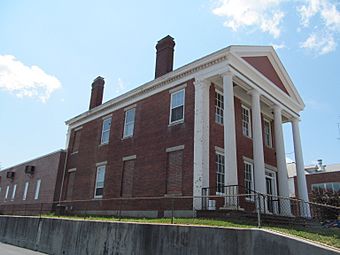Tiffany-Leonard House facts for kids
Quick facts for kids |
|
|
Tiffany-Leonard House
|
|

Tiffany-Leonard House
|
|
| Location | 25 Elm St., Southbridge, Massachusetts |
|---|---|
| Built | 1832 |
| Architectural style | Greek Revival |
| MPS | Southbridge MRA |
| NRHP reference No. | 89000590 |
| Added to NRHP | June 22, 1989 |
The Tiffany-Leonard House is a special old building located at 25 Elm Street in Southbridge, Massachusetts. It's also known as the Southbridge News building. Built around 1832, it's a great example of a building style called Greek Revival. This house is important because of its unique look and the important people who once lived there. It was added to the National Register of Historic Places in 1989, which means it's a protected historical site.
About the Tiffany-Leonard House
This historic house stands on the east side of Elm Street. It's just south of downtown Southbridge. Across the street, you can see the Elm Street Fire House.
What Does It Look Like?
The Tiffany-Leonard House is a beautiful two-story building made of brick. It has a roof that slopes down to the front. The house sits on a strong foundation made of granite stone.
Its most striking feature is a large porch at the front. This porch has four tall, round columns that reach from the ground to the roof. These columns support a triangular roof section, like the front of an ancient Greek temple. The columns have vertical grooves, and the triangular roof has decorative teeth-like blocks. The corners of the house also have flat, column-like decorations. Windows, some of which are now filled in with brick, have stone tops and bottoms.
Who Lived Here?
The house was built around 1832 for a man named Bella Tiffany. He was a successful businessman. Bella Tiffany worked with Samuel Slater, who was famous for owning mills. Together, they started the first cotton mill in nearby Webster. Bella Tiffany was also the president of a local bank. He even served in the state legislature, which means he helped make laws for the state.
Later, around 1855, the house became home to Manning Leonard. He owned the house until the late 1800s. Manning Leonard was also a local businessman and a politician. He owned a large part of a company called the Central Manufacturing Company.



